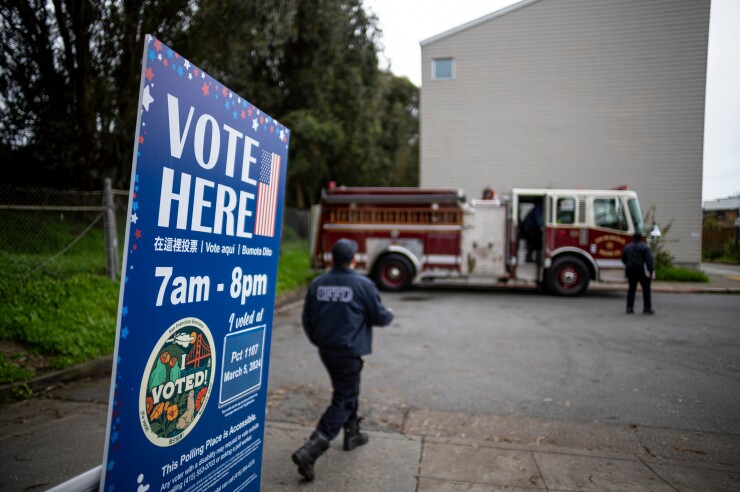California's presidential election ballot in November will include $20 billion dollars of statewide bond measures, with $20 billion more in one regional bond election.
At the state level, lawmakers reached agreements last week on two $10 billion general obligation bond measures that were heading toward approval in floor votes this week.
The measures were put forward

Those measures will compete for attention on the ballot in what some are expecting will be a record year for school district bond measures, in an election already juiced with a $20 billion regional housing bond measure in the San Francisco Bay Area.
The statewide measures were put forward
Supporters say the school bond would improve the lives of millions of kids and modernize public schools, while the climate bond would fund clean water, wildfire prevention and recovery projects.
"These bond measures are critical to the future of this state, and invest in our kids, their neighborhood schools, and they ensure communities big and small have access to clean drinking water and are wildfire safe," said Sen. President Pro Tempore Mike McGuire, D-Healdsburg.
The Senate leader added that he ran for the school board at the age of 19 after seeing his high school fall into disrepair.
"Our students, teachers and staff deserve better, especially those in underserved schools where resources are limited and facilities are outdated, and at times, dangerous," McGuire said.
Proposition 51, the last statewide bond measure to support school construction, was approved by voters in November 2016 and has long been depleted.
If the statewide school bond measure passes, local districts will need matching funds to secure state money.
"I think we are going to see a record number of GO school bond measures on the ballot in 2024," said Adam Bauer, president and chief executive officer of municipal advisory firm Fieldman, Rolapp & Associates.
In 2020 and 2022, the number of school bond measures on the ballot was light, and the need for school construction funding has remained, Bauer said.
"In 2024, school districts have been ramping up to make up for the lack of bond measures floated over the past cycles," he said.
He confirmed that school districts are running into situations where they don't have enough money for projects because they haven't passed a bond in a while.
"That's exactly right, and they are hopeful the state would put a measure on the ballot to help with matching funds," he said.
Of the statewide climate bond measure, McGuire said the communities he represents have been devastated by wildfires. Ensuring that the state's communities have the resources to protect themselves from wildfires, drought and floods is "critical to the long-term success of the state," he said.
"Our historically underserved communities on the front lines of the climate crisis could not afford to wait any longer, requiring us to move with urgency to strengthen California climate resiliency," said Assemblymember Eduardo Garcia, D-Coachella, who co-lead the Assembly climate bond working group with Assemblymember Lori Wilson, D-Suisun City.
SB 867 would commit a minimum of 40% of the bond funds toward disadvantaged communities.
The money would be divided seven ways: $3.8 billion for safe drinking water, drought and flood protection; $1.5 billion for wildfire and forest resilience; $1.2 billion to deal with sea level rise; $1.2 billion to protect biodiversity; $1.55 billion for park creation and outdoor recreation areas; $450 million for extreme heat mitigation; and $300 million for climate-friendly and resilient ranches and farms.
The climate bond would invest in "our future by prioritizing critical needs such as safe and affordable drinking water access, wildfire prevention, extreme heat mitigation, sustainable agriculture, and clean, renewable energy," Wilson said.

The $20 billion regional general obligation bond measure in the San Francisco Bay Area would help build or preserve 90,000 affordable homes across the nine-county region, supporters say.
The Bay Area Housing Financing Authority Board, a regional board comprised of local elected officials, unanimously agreed at their June 26 meeting to place the Bay Area's first regional housing bond on the general election ballot.
Only 17% of the state's homebuyers can afford the state's $814,280 median-priced single family home, with 24% able to afford a $655,000 median-priced condo or townhome, according to a California Association of Realtors
To afford a single-family home, according to the CAR's calculation, buyers need to make $208,400 annually to make monthly payments of $5,120, including principal, interest and taxes on a 30-year fixed-rate mortgage with a 6.86% interest rate.
San Mateo and Santa Clara — two counties in the BAHFA region — are the first and second most costly areas to purchase a home, according to CAR.
If approved, $10.4 billion would go to build 36,000 affordable homes, $3 billion would go to preserve 14,000 existing affordable homes and $6.6 billion would be used as flexible funding to preserve and provide homebuyer assistance for 22,000 homes, according to a report.
Under current law, the BAHFA measure would require approval by at least two-thirds of voters to pass. The bonds would be repaid with the ad valorem property tax levy in the nine-county region.
But the state's voters will also be considering Assembly Constitutional Amendment 1, which would set the voter threshold at 55% for voter approval of bond measures for affordable housing and infrastructure. According to BAHFA, if ACA1 passes, the authority's bond measure would only need a 55% vote threshold.
"Today's vote is the culmination of so many years of effort by so many people all around our region," BAHFA chair Alfredo Pedroza, a Napa County supervisor,
The bond measure would split 80% of the funds between the nine counties (and the cities of San Jose, Oakland, Santa Rosa and Napa, each of which carries more than 30% of their county's low-income housing need), in proportion to each county's tax contribution to the bond. The remaining 20%, or $4 billion, would be used by BAHFA to establish a new regional program to fund affordable housing construction and preservation projects throughout the region.
The measure also would create a citizen's oversight committee and bond proceeds account. The committee would report to BAHFA and the Association of Bay Area Governments executive boards. There would also be an annual independent audit.
It remains to be seen if voters will have the same enthusiasm to approve bond measures as the authors have for the programs they would support.
Sonoma State University political science professor David McCuan pointed out that Gov. Gavin Newsom and lawmakers already made efforts to lighten the burden placed on voter's attention by
"There could have been 22 to 24 statewide initiatives on the ballot; instead there will be nine to 11," McCuan said.
"There is a lot weighing on voter's pocketbooks already, along with it being a contentious election year," he said.
Consider all the attention being given to the battle between former President Donald Trump and President Joe Biden, he said.
"Bond measures have done pretty well at the local level in the last 10 or 15 years, but California has been approaching the bond indebtedness ceiling," he said. "When that condition happens, it's easier to get a 'no' than a 'yes' vote."
Local ballot measures, including but not limited to tax and school bonds have notched a 70% approval rate, and statewide measures have experienced a from 33% to 38% approval rate in the last 10 years, he said.
McCuan anticipates that fiscal measures, bond measures and measures to change voter thresholds will not fare as well as they have in the past. If they were grabbing 70% of the vote previously, he's predicting the average approval rate to drop as low as 50%.





